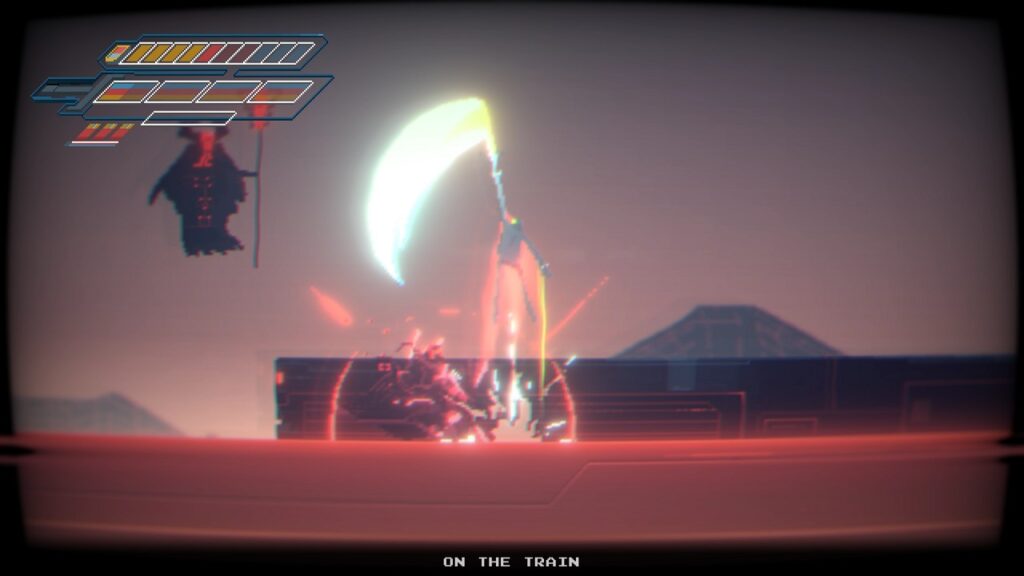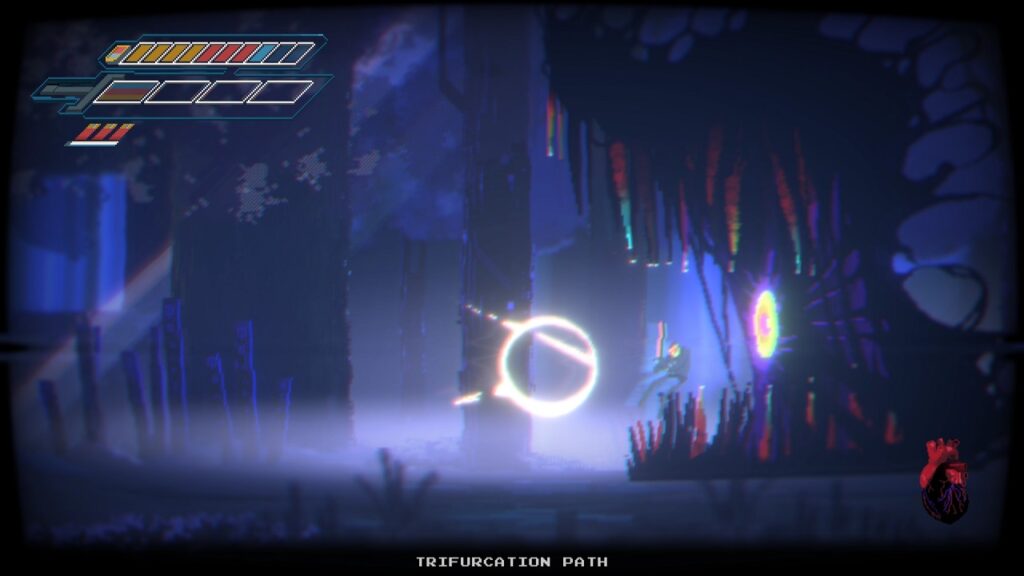
Developer: Studio Koba
Publisher: Team17
Platform: Switch, PC, PS4, Xbox One
Tested on: Switch, PS4
Narita Boy – Review
On January 9th, 2017, Studio Koba dropped the first teaser trailer for Narita Boy. Four years and a successful Kickstarter campaign later, the much anticipated retro title is finally here. Was the 80s inspired Metroidvania title worth the long wait? We picked up our Techno Sword and ventured deep into the Digital Kingdom to find out.
Story
From the opening scenes, it’s clear that there is a lot of lore behind the story of Narita Boy. The game takes place in the Digital Kingdom, which is inside a video game, offering a meta element to the narrative. The in-game version of Narita Boy is the best-selling video game of all time, but the cartridges hide a virus, called HIM. HIM manages to cross over to the real world and steals the memories of The Creator, the developer that created Narita Boy. Fortunately, there is a gamer that can stand up to HIM. Through the power of technology, the Motherboard summons this gamer to the Digital Kingdom, in the form of the real Narita Boy.
The tutorial also serves as a way to set up the backstory, which feels convoluted and complex at first, simply because of the sheer amount of information that is thrown at you. The gist is that there is a prophecy that explains how Narita Boy is the Chosen One, who was summoned to the Digital Kingdom to take on HIM. Narita Boy must use the Techno Sword to take down HIM’s forces and restore the stolen memories. It’s technically a simple premise, but you’re bombarded with snippets of lore during the first twenty minutes of the game that hint at a deep backstory that almost rivals the writings of Tolkien. As you make your way through the game, you’ll run into characters that were mentioned during the prophecies and stories that litter the game, and things gradually become more clear.
Graphics
Narita Boy fully embraces the aesthetics of 80s video games, and looks absolutely gorgeous. Retro enthusiasts will get a kick out of how the game looks and feels. The game takes cues from TRON and Star Wars but manages to successfully create its own visual identity. That said, the game embraces the 80s aesthetic but also looks modern, because of how fluid everything moves. The character animations are simply gorgeous, especially during combat. The obligatory CRT filter is also present, although we do recommend turning this off. While it makes the game feel more authentic, it also detracts from the gameplay experience, simply because the CRT distortion effect is a bit too strong.
Sound
Composer Salvinsky’s synthwave soundtrack is perhaps the best thing about Narita Boy. Given the gorgeous visuals and well-crafted gameplay, that’s saying a lot. We found ourselves returning to the OST well after we were done playing the game. We highly recommend checking out the music on YouTube to experience it for yourself. The Daft Punk-esque Narita Boy Theme track is especially wonderful and should find its way to your playlist. Given the game’s reliance on retro aesthetics, there is no voice acting -apart from the “Narita….BOY” on the opening screen- and sound effects are an afterthought, giving the music front stage.
Gameplay
Metroidvania-style platformers are a dime a dozen, and the level of quality is often so-so at best. It’s refreshing when you encounter one that manages to rise up from the puddle of mediocrity and that actually nails what it attempts to do. Thankfully, Narita Boy does so. This is a great Metroidvania game, albeit not a perfect one. A lot in the appeal is, as we mentioned, in the 80s aesthetic that the game perfectly captures. However, we were very pleased to discover that Narita Boy isn’t a case of style over substance.
Narita Boy is satisfying to play, thanks to its tight control scheme and the way you gradually unlock new combat moves. Players are eased into the game’s more complex and powerful moves thanks to the game’s excellent pacing. This also creates a sense of character growth, which is more satisfying in the long run, instead of getting everything handed to you on a silver platter. Early on, you only have your trusty Techno Sword to rely on, although this is a powerful weapon in its own right. Apart from your typical hack-and-slash moves, you can also use the Techno Sword to unleash shotgun-like blasts, although doing so consumes energy, which slowly recharges over time. Later on in the game, you’ll gain access to Wild Fire abilities. Enemies appear in different colors and activating a Wild Fire ability that matches an enemy’s color turns Narita Boy into a glass cannon against these enemies. You’ll deal massive damage to them, but the tradeoff is that you’ll also experience a massive drop in defense against their attacks.
The Wild Fire abilities add a degree of strategy unlike anything we’ve seen in a Metroidvania game before. Do you go in attempting to take out everything in one fell swoop before the enemies can slay you or are you more conservative with them? Given that the ability is limited in use, being able to know when to use it can be the key to victory. While using a Wild Fire ability, you’re also able to call upon a Dude of Trichroma, who acts as an AI sidekick. Once again, this requires energy to use, so striking the right balance is key, alongside selecting the right tools to take on your enemies. There is a decent amount of variety of enemy types, and their attack patterns differ enough to keep you on your toes at all times. Naturally, the game also features a diverse lineup of boss battles, which are challenging, and most importantly, fun.
For the most part, the levels are well designed and a joy to explore. Admittedly, the lack of a map is a bit frustrating, because although the environments you traverse aren’t overly complicated in their layout, it can still be a bit vexing to navigate them without getting lost one or two times. Finding hidden Techno Keys is a core element in the game. These are necessary to progress to the next area. Occasionally, backtracking to the door that matches the key you just picked up is almost as challenging as finding the key in the first place because you have no way to keep track of the layout of the area you just traversed. All things considered, this is a minor nitpick, as you’ll gradually become familiar with the levels by simply playing through them.
Conclusion
If you’re a Metroidvania enthusiast or simply a fan of the current 80s revival, then you’re going to want to pick up Narita Boy. The game is a love letter to that decade, but also feels suitably modern. It’s well crafted, even if navigating the world can be a bit vexing and the way the backstory is blasted at you is overwhelming. Don’t be deceived by the price of entry, which seems a bit steep, as Narita Boy is well worth every penny.
Narita Boy - Review,









No Comments